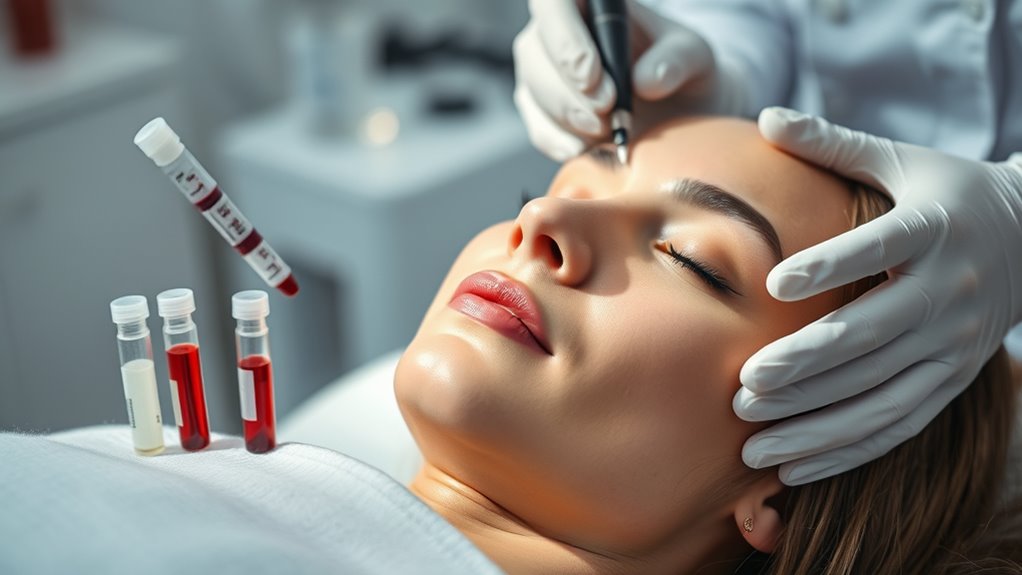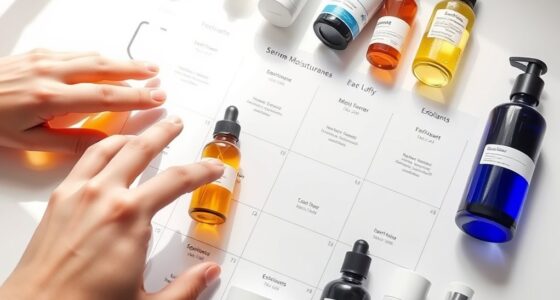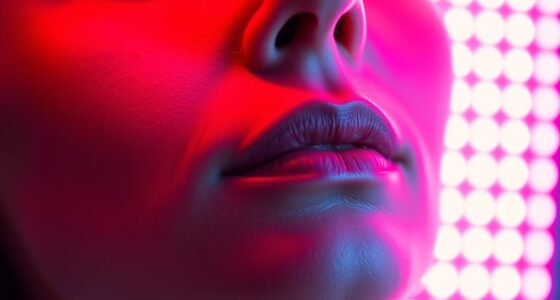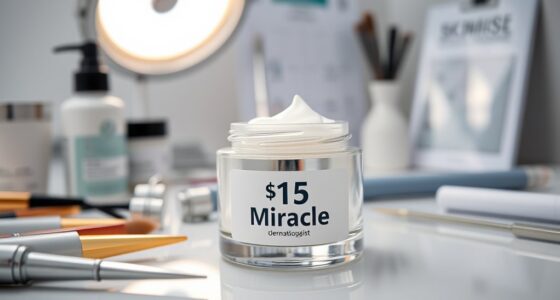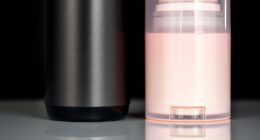A PRP facial, or “vampire facial,” involves drawing your blood, processing it to extract platelet-rich plasma, then injecting or applying it to your skin to stimulate healing and boost collagen. Benefits include improved skin texture, firmness, and a natural glow, with results appearing in weeks. While risks are minimal—like mild redness or swelling—it’s safest when performed by a qualified professional. Keep exploring to discover the full process, advantages, and safety tips.
Key Takeaways
- PRP facial involves drawing blood, isolating platelet-rich plasma, and injecting or applying it to stimulate skin rejuvenation.
- The treatment promotes collagen and elastin production, improving skin firmness, texture, and overall glow.
- It offers benefits like reducing fine lines, scars, and enhancing blood flow, with visible results in a few weeks.
- Common risks include mild swelling, redness, bruising, and rare infection, especially when performed by qualified professionals.
- Proper aftercare and hygiene are essential to minimize side effects and ensure safe, effective results.
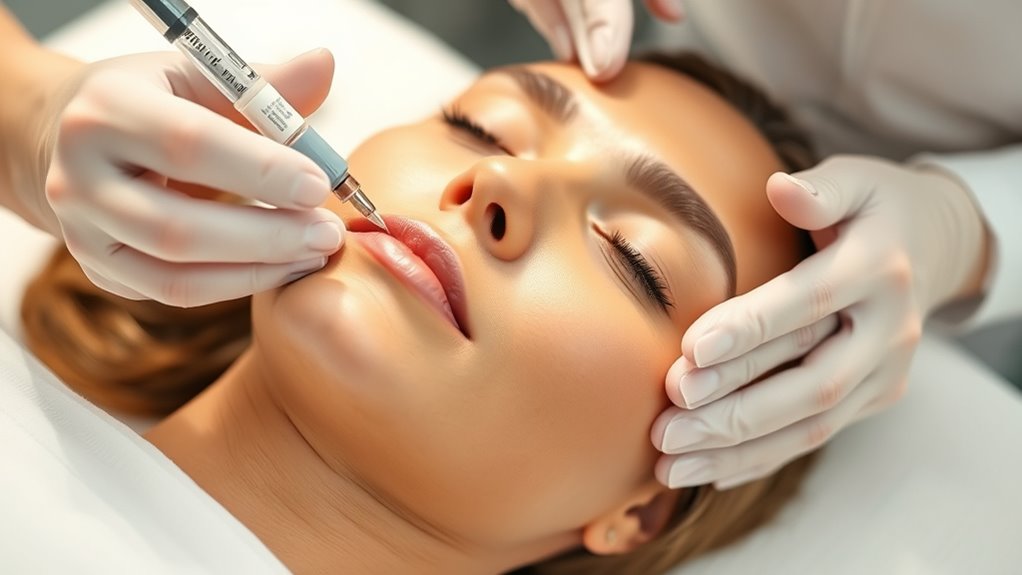
A PRP facial, also known as a vampire facial, is a popular skincare treatment that uses your own blood to promote skin rejuvenation. During the procedure, a small amount of blood is drawn from your arm, then processed to isolate platelet-rich plasma (PRP). This plasma contains a high concentration of platelets, which are essential for healing and tissue regeneration. When injected or applied to your face, the PRP stimulates your skin’s natural healing processes, leading to a fresher, more youthful appearance.
One of the key mechanisms behind a PRP facial is platelet activation. Once your blood is processed, the platelets are activated, releasing growth factors that trigger a cascade of biological responses. These growth factors encourage the production of collagen and elastin—two proteins indispensable for maintaining skin elasticity and firmness. As a result, your skin becomes tighter, smoother, and more resilient over time. Platelet activation also promotes the formation of new blood vessels, improving blood flow and nutrient delivery to your skin, which enhances overall skin health and radiance. AI-driven innovations in medical treatments are increasingly improving the safety and effectiveness of procedures like PRP facials.
Platelet activation boosts collagen, elastin, and blood flow for healthier, more resilient skin.
The process begins with a blood draw, followed by centrifugation to separate the PRP from other blood components. The concentrated platelet-rich plasma is then either injected into targeted areas of your face or applied topically with microneedling to create tiny channels that allow the PRP to penetrate deeply. This stimulation prompts your skin cells to regenerate more efficiently, reducing the appearance of fine lines, wrinkles, and scars. Many people notice improvements in skin texture, tone, and glow within a few weeks after treatment, especially as collagen production ramps up.
While a PRP facial offers significant benefits, it’s not without risks. Since the treatment involves injections or skin punctures, there’s a small chance of infection, redness, or swelling. Some individuals may experience temporary bruising or discomfort at the injection sites. It’s essential to follow your provider’s aftercare instructions to minimize these risks and guarantee optimal results. Also, because the treatment uses your own blood, the risk of allergic reactions is minimal, making it a safe option for most people.
Ultimately, a PRP facial leverages your body’s natural healing abilities through platelet activation to promote skin rejuvenation. It’s a minimally invasive procedure that can help restore youthful vitality to your skin, but it’s crucial to have it performed by a qualified professional to guarantee safety and effectiveness. With proper care and realistic expectations, you can enjoy a more vibrant and refreshed look that reflects your skin’s true health.
Frequently Asked Questions
How Long Does a Typical PRP Facial Session Last?
A typical PRP facial session lasts about 60 to 90 minutes, depending on your skin’s needs and the areas being treated. During the session, the facial duration includes cleansing, PRP application, and any additional skincare steps. The session length can vary slightly based on individual factors, but most people find it to be a convenient and relatively quick procedure that fits into a busy schedule.
Can PRP Facials Be Combined With Other Skincare Treatments?
Yes, you can combine PRP facials with other skincare treatments for enhanced results. This combination therapy offers skincare synergy, targeting multiple skin concerns simultaneously. For example, pairing PRP with microneedling or chemical peels can boost collagen production and improve skin texture. Just make sure to consult your dermatologist to guarantee the treatments complement each other and suit your skin type, minimizing risks and maximizing benefits.
What Is the Cost Range for a PRP Facial?
You can expect PRP facial costs to range from $500 to $2,000 per session, depending on your location and provider. Prioritize pricing transparency to understand what’s included and avoid hidden fees. While the treatment offers notable benefits, consider treatment affordability and weigh it against your skincare goals. Some clinics may offer packages or discounts, so ask about options to make your PRP facial more budget-friendly.
Are There Any Age Restrictions for Getting a PRP Facial?
Think of your skin as a garden that needs tending. Age suitability for PRP facials depends on your skin maturity, not just your birth date. Usually, if you’re an adult with healthy skin, you’re a good candidate. There’s no strict age limit—it’s more about your skin’s condition than your age. As long as your skin can heal and regenerate, you can enjoy the rejuvenating benefits of a PRP facial.
How Soon Can I Expect to See Results After Treatment?
You can typically expect to see visible improvements within 2 to 4 weeks after your PRP facial treatment. The timing expectations vary depending on your skin’s response and individual healing rates. While some clients notice subtle changes sooner, others might see more pronounced results after a few months. Keep in mind that consistent treatments can enhance and prolong your results, so follow your provider’s recommendations for the best outcome.
Conclusion
Think of a PRP facial as planting a seed of renewal beneath your skin’s surface. With patience and care, this tiny act of nourishment can blossom into a radiant, youthful glow, symbolizing your commitment to self-care. Just as a gardener trusts in the process, trust in this treatment’s potential to restore and revive. Embrace it as a quiet act of hope—a reminder that beauty, like nature, continually regenerates from within.
